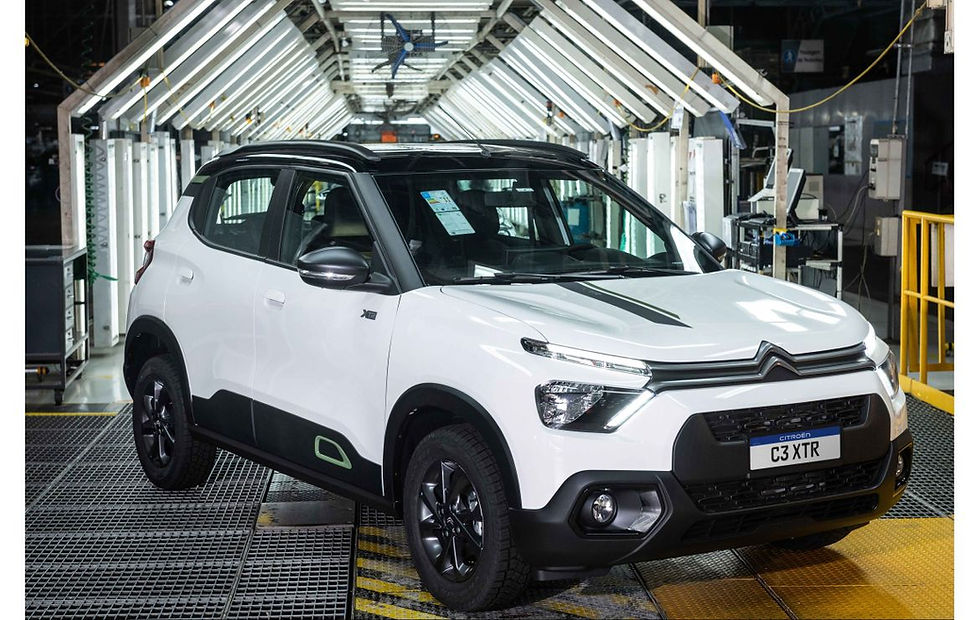Citroën in India: Analysis of a difficult start and future prospects
- Jérémy

- Apr 2
- 4 min read

Citroën had high ambitions for the Indian market, a strategic area with strong growth potential. However, despite the launch of several models from its C-Cubed range and recent updates (August 2024) to make them more competitive, the chevron brand is struggling to find its feet and is posting disappointing sales results. The situation has become worrying enough to cause concern, even anger, among its dealer network. Faced with this difficult situation, can Citroën reverse the trend and finally succeed in its bet on India? Here are some answers.
The C-Cubed programme meets the realities of the Indian market
To conquer India, Citroën relied on its "C-Cubed" programme, which resulted in three models designed specifically for emerging markets: the C3 city car, the C3 Aircross SUV and, more recently, the Basalt SUV coupé. The aim was clear: to offer modern, robust and accessible vehicles. Unfortunately, when they were launched, these models suffered from poor positioning and, above all, a lack of equipment considered essential by local customers. The C3, for example, was criticised for lacking certain refinements expected in its category, while the C3 Aircross, launched in the highly competitive SUV segment, also suffered from notable omissions (such as the initial lack of cruise control) compared to its direct rivals. The C5 Aircross did not achieve the expected success either, as its price was considered too high. The ë-C3, the electric version of the C3, has gained some traction with corporate fleets, but volumes are still insufficient to ensure the brand's longevity in the private market. The latest Basalt seems to be following a similar trajectory, struggling to win over a customer base that has become increasingly cautious. These successive launches, marked by products perceived as lacking in features or failing to live up to expectations, have seriously undermined buyer confidence and complicated the task of dealers. In this context, how can Citroën hope to recover and win back the favour of the Indian public?
A fresh start in India and beyond
Despite this complex picture, the game is not necessarily lost for Citroën in India. There are several levers that can be pulled to turn the situation around, but they require swift action and a thorough rethink of the original strategy. The first priority is to address the growing concerns of the dealers. These essential partners, who have invested heavily in the brand's image, cannot continue to suffer financial losses. Greater support from Citroën is essential, through improved margins, financial incentives and a fairer distribution of marketing costs. Without a strong and motivated network, it will be impossible to win back the market.
On the product front, a major change is needed. It is essential that Citroën stops seeing India as a "low-cost" market and starts offering vehicles that offer real value for money. This doesn't just mean lowering prices, but above all incorporating the features and technologies that modern Indian consumers expect from the outset: safety, connectivity, comfort and a certain perception of quality, even in the entry-level segments. Late updates to address initial shortcomings are no longer enough to regain the interest of customers who have already turned to the competition.
Marketing and branding also need a major overhaul. Citroën currently suffers from a lack of awareness and desirability in India. Massive investment is needed in high-impact communication campaigns that highlight the brand's DNA (comfort, bold design) while adapting it to local sensibilities. An emotional connection must be created with Indian buyers so that they see Citroën as a credible alternative to established brands.
Finally, the parent company, Stellantis, needs to clarify and reaffirm its long-term commitment to the Indian market. Past management instability, both locally and internationally, has sown doubt. A strong signal, backed by concrete investment in R&D, better product localisation and a clear roadmap for future launches, is essential to restore confidence among distributors and customers. It should be noted that India also serves as an export platform for Citroën to other regions, notably Southeast Asia (such as Indonesia) and Africa (such as South Africa). While these markets contribute to the overall volume of the Indian plant, they remain significantly smaller than the Indian domestic market, whose growth potential remains the main challenge. Success in these export markets will also depend in part on Citroën's ability to prove its relevance and robustness in India itself.
Citroën's debut on the Indian market was undeniably difficult, much more so than the brand had expected. There are many reasons for this: an initial sales strategy that was ill-suited to the local context, product choices that did not immediately meet consumer expectations in terms of equipment, management instability and perhaps a lack of detailed understanding of the specifics of this highly competitive market. Factors related to Stellantis' overall strategy may also be at play. But the story is not yet written. Citroën has the industrial and technical resources to turn the situation around. If the brand listens carefully to feedback from the field (customers and dealers), adapts its product range to make it more attractive from the outset, invests in building its image and benefits from a clear and lasting commitment from Stellantis, it is still possible to reverse the trend. The road will be arduous, but the potential of the Indian market justifies a sustained effort to turn this difficult trial into a lasting success. Stellantis' willingness and ability to lead this strategic overhaul will be crucial.






Comments